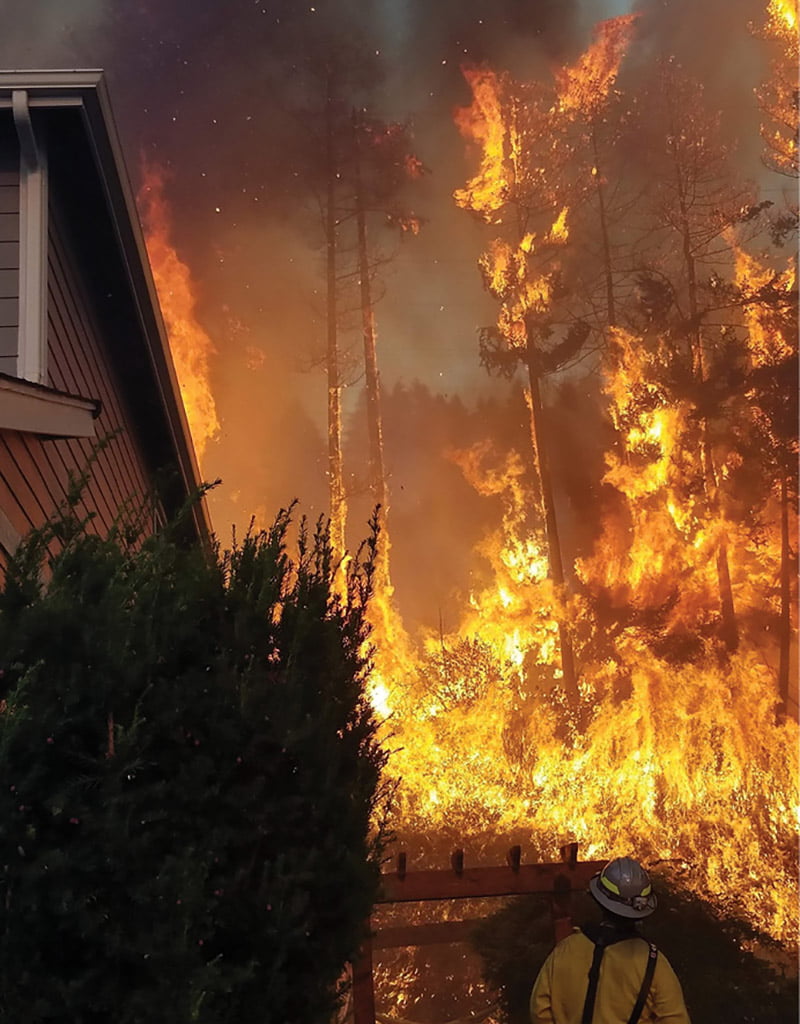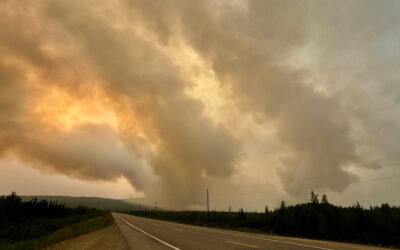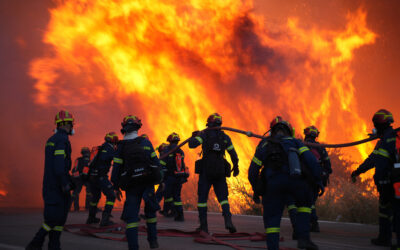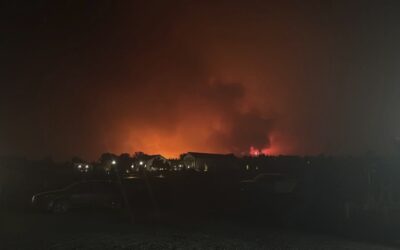A few years ago, I was talking to one of my captains about a “small” brush fire that had occurred the previous shift. I was off that day and was interested in how the incident went. The fire involved two to three acres located off a major roadway. The terrain was steep, and the fire had traveled uphill into an area that had moderate to heavy fuels with several homes at the top. The initial call was coded as a “smoke investigation,” which dispatched a single structure engine to the incident location.
Engine 1 found a slow-moving vegetation fire. The company officer requested another engine company to assist and went to work. The engine company was in bunker gear without self-contained breathing apparatus (SCBA) and extended off a 200-foot, 2½-inch preconnected hoseline with a 150-foot, 1¾-inch bundle.
As Engine 1 worked their way up the hill, they encountered a fair amount of brush interspersed with some large evergreens. This is very common fuel type and terrain in the Pacific Northwest. Also, very common in western Washington is a deep layer of decaying needle cast and leaves covering the ground under the trees called duff. Engine 1 worked the fire on the north flank while Engine 2 was directed to attack the southern flank. Engine 2’s crew was also in bunker gear with no SCBA. Recognizing a future need for more water, the Engine 1 officer requested two more engines because there were no hydrants in the immediate area.
As the engine companies reached a “bench” on the slope and had extinguished most, if not all, of the visible fire, it was decided to take a quick break because both crews needed to cool down and hydrate. They had been working hard and were in bunker gear. During this break, a slight breeze picked up and the crews realized that the smoke from the fire was getting more intense with a significant increase of heat. A large pocket of vegetation that was directly below the crews had ignited and was rapidly burning up to the bench where the engine companies were taking a break. One of the company officers fortunately saw a viable escape route and directed the crews to move laterally on the slope to escape the fire, which was now rapidly moving uphill toward them. They were able move across then back down the slope to their engines and reengage the fire in a vegetation pocket.


(1) The Sumner Grade Fire happened in early September 2020 in a suburb just east of Tacoma, Washington. It started in the interface and quickly threatened numerous homes and other structures. Although this photo demonstrates how close it got to structures, providing adequate space and knowing how to function in the interface enabled firefighters to save this local firefighter’s home. (Photos by Rick Olson.)
At the time, my agency did not have a formal training program for wildland or interface fires. Fortunately, one of the company officers recognized they were in a very dangerous situation. Because of the lack of training, the crews did not have a lookout. When engaged in wildland urban interface (WUI) fires, lookouts are very important. They are the eyes and ears of the crews working. The terrain and vegetation may make it difficult to see what a fire is doing. Lookouts, communications, escape routes, and safety zones (LCES), a standard wildland training item, will be discussed below.


(2) The same house after the fire. Note the clear line of undamaged property. This is a best-case scenario. The Sumner Grade Fire burned about 500 acres and several structures; it was a wake-up call for the Pacific Northwest. In 2021, the Bolt Creek Fire north of Seattle, Washington, burned more than 14,000 acres and threatened numerous towns and structures. The fire burned for more than a month, closing a major east/west highway several times.


(3) This house was saved by WUI structural defense tactics.
Near Miss
This near miss shows how a small brush fire can be catastrophic. It was only two to three acres—a little smaller than two to three football fields. It was not a huge wildfire in a national forest or in a rural area; it was in middle of an urban area. Certainly, it was a wake-up call that without WUI firefighting training, structural firefighters can unknowingly put themselves in harm’s way. It also confirmed that even small WUI fires can be just as dangerous as large wildfires.
This is why structural firefighters must be trained in interface firefighting safety, strategies, and tactics. As I have traveled the country teaching, I have heard numerous other near-miss examples. Fortunately, my agency and its neighbors have recognized the risks and implemented a formal training program for both WUI and wildland firefighting. Many of you who have received this type of training hopefully recognized many red flags in the story. Your training will help you to avoid the same mistakes and assist you in operating safely and effectively in this type of fire environment.
For those of you who still don’t think you need training or who don’t have WUI in your jurisdiction, let’s look at the numbers. One of our biggest challenges in the United States and Canada is fire that occurs in the WUI. The United States Fire Administration (USFA) defines the WUI as “the zone of transition between unoccupied land and human development. It is the line, area, or zone where structures and other human development meet or intermingle with undeveloped wildland or vegetative fuels.” The WUI exists in every state and province. The interface is where structures have vegetation in close proximity to their location. Unfortunately, many fire departments (especially those in urban areas) don’t realize that parks, green belts, and nature areas can also create WUI fires that may cause tremendous damage to structures and infrastructure.
These type of fires in the right conditions create a tremendously dynamic fire environment for which many structural firefighters have little to no training. This is not only a hazard to the public and their property but is also very dangerous for firefighters. In the 2015 and 2020 National Fire Protection Association (NFPA) Needs Assessment Survey, it was found that 80% of fire departments reported that they are the primary firefighting force responsible for WUI fires. It also was found that 70% of those fire departments have little to no formal training on how to operate safely and effectively in the WUI environment to suppress these fires.
For decades, WUI fires were considered a West Coast problem; that is no longer true. In fact, the USFA lists the top five states with the most homes or structures that “live” in the interface as California, Texas, Florida, North Carolina, and Pennsylvania. While California as number one is no surprise, Texas, Florida, North Carolina, and Pennsylvania are nowhere near the West Coast.
How Did We Get Here?
Why are we are seeing more WUI fires? First, with urban sprawl, we are moving farther and farther into the interface. The very same vegetation that makes “the country” so beautiful is fuel. Weather patterns are changing because of climate change, so we are seeing more extreme weather including hurricanes and tornados. Also, there is drought from lack of rain in some areas and increased rain causing more vegetation growth in others. Post COVID-19, much of the public has been enjoying the outdoors more than before. Also, in more urban areas, temporary residents have occupied many green spaces. Coincidentally, most WUI fires are human caused.
Inside vs. Outside of a Box
Structural firefighters receive training on subjects that are not structural firefighting but are still related to our job—emergency medical services (EMS), hazardous materials, confined space, rope rescue, and the list goes on. We are really good at aggressive interior firefighting. We are trained in how to read buildings, read smoke, vent-enter-isolate-search, perform forcible entry, and observe fire behavior, which all makes us better and safer. But that training is specifically for fires “inside of a box.”
Fire Triangle for Wildfires
What training have you received for fire that is “outside of a box”? We understand how a “fuel-limited” or “vent-limited” fire should behave. It is imperative that we now understand how different fire is when it is outside of a box. For interior firefighting, the legs of the ignition fire triangle are fuel, oxygen, and heat. For fire outside or in the interface, the fire behavior triangle legs are fuel (light to heavy), weather (primarily wind), and topography (slope). As you can see, they can be very different. Urban interface fires are no longer low-frequency events; they have become higher frequency and remain high risk.
Wind (weather). After ignition, this is the greatest contributing factor to fire spread. Wind not only fans the flames but causes embers from what is burning to travel great distances. It also preheats the fuel downwind, making it more receptive to ignition. In the interface, the wind causes the fire in structures to “lay down” and ignite other nearby structures. It can also ignite fires downwind from the embers landing on flammable material around structures, which now act as wicks or fuses to other structures on fire. Ember cast is the most common ignition source in WUI fires.
Slope (topography). Everyone has seen a fire “run” up a hill. Most regions of the country have areas with homes atop slopes for the view. Many have major roadways with slope on the shoulders of the roadway that possibly have structures on the top. Fires that get going upslope often move considerably faster than those that are on level ground. This is without wind; with wind, the fire will grow exponentially faster.


(4) Unfortunately, this home was lost in the fire. The firefighters protecting the exposure property are wearing wildland personal protective equipment (PPE). Fires in the interface are dynamic; firefighting personnel must remain mobile. Because of the lack of resources in the early stages of these types of fires, crews cannot commit to interior firefighting. This is hard for structural firefighters to do; it’s a change to our paradigm. It’s why we must have the training and appropriate PPE for such events.
Fuel (light to heavy). Wildland firefighters use several fuel models to help predict how fast a fire will spread. For the structural firefighters in the interface, it can be a little simpler. Light fuels are grass or grass-like vegetation; moderate fuels are shrubs, light brush, and small trees. Heavy fuels are heavy brush and medium to large trees. The smaller the fuel diameter, the more readily it will ignite—grasses quickly and large trees more slowly.
Fuel continuity is another very important aspect of fuels. It refers to the structure of the fuels within an environment that are connected both horizontally and vertically, which relates to how easily fire can spread from fuel to fuel. All things being equal, those environments with dense fuels that essentially touch or are close to touching (ladder fuels) will have higher (faster) fire spread rates; those areas where fuels are sparser or spread apart and not touching will tend to have lower (slower) rates of spread. For example, continuous grasses may ignite bushes, which may ignite trees and so forth, all based on how continuous the fuels are in the fire area.
Structures as Fuels
When WUI fires impact structures, the structures can turn into the fuel that drives the fire that can be self-propagating. Structure-to-structure ignition from direct flame contact is most commonly believed to be the primary ignition source but is relatively rare. Ember cast is the primary driver of the fire and what most commonly ignites structures. According to the National Institute of Standards and Technology (NIST) report from the Waldo Canyon Fire in 2012, of the 347 structures destroyed, 54% of those burned because of ember cast while only 16% burned because of structure-to-structure ignition. The other 30% resulted from direct flame contact from the fire front or from vegetation too close to the structure.1 Ember cast can ignite structures that are a significant distance from the main body of the fire. It is imperative to implement a tactical patrol to suppress spot fires and structure ignition while they are still in their infancy.
Major Operational Differences in Interface Fire
Fire departments commonly arrive at interface fires and start suppression operations at the point of origin and are distracted from paying attention to where the fire is going. This is very common when dispatched to a fire that has started on a roadway. Generally, there are light fuels in the median and on the shoulders. Adjacent to those light fuels, however, may be structures with receptive fuels; numerous structures have ignited and burned while the primary focus was on the grass fire on the roadway. This, unfortunately, is what has always been done. This paradigm must be changed, allowing company officers to think outside of the “box.”
Thinking Outside of the “Box”
In structure firefighting, the incident commander (IC) is usually static, either working from inside his rig or just outside of it. Because fires in the interface are so dynamic, the IC must be agile and mobile unless he can establish a relatively unobstructed view of the fire. In the roadway fire example above, very possibly the IC will need to start setting up operations to defend nearby structures. An overpass above the roadway or a generally elevated viewpoint would provide a perspective to better understand the incident’s complexity, which may be a shift from the norm.
Often, the IC must rely on company officers to clearly communicate what the fire is doing and where it is going. Interface fires require ICs to have a different set of tools to effectively command and control an incident—for example, the ability to use mapping tools to better understand where the fire is headed; pre-fire planning for neighborhoods, not just individual buildings; the consideration of sacrificing structures to save neighborhoods; and the ability to order resources needed to suppress a fire early.
The ability to recognize the potential of an interface incident generally falls on the first-in company officer. The knowledge of the first-due area in the initial phase of the incident can make or break the outcome. Understanding the fire behavior encountered on arrival is also key. So is the ability to communicate and forecast what the fire is doing, where it is going, how fast it is moving, the fuel driving the fire, and what is potentially in its way. This initial size-up will assist the IC in making the decisions that are important to the command and control of the incident. Understanding fire outside the box will give the first-in officer the knowledge and confidence for where and how to engage the fire. Unlike structure fires, in which the IC dictates the strategies and tactics and drives communication, the company officer may have to make independent decisions because of the interface incident’s geographic size and complexity. These independent decisions should be made based on the “leader’s intent”; they should not be considered freelancing, as the two situations are different.
Leader’s Intent
The National Wildfire Coordinating Group (NWCG) describes the leader’s intent as follows:
“In fast-moving, dynamic situations, top-level decision-makers cannot always incorporate new information into a formal planning process and redirect people to action within a reasonable timeframe.
“We provide leader’s intent so company officers closest to the action can adapt plans and exercise initiative to accomplish the objective when unanticipated opportunities arise or when the original plan no longer suffices.”
The leader’s intent is a crucial element of effective operations because it reduces internal friction and empowers subordinates—even when chaotic conditions prevent the chain of command from communicating effectively. The leader’s intent is a clear, concise statement about what people must do to succeed in their assignments. It delineates three essential components: task, the assignment’s objective or goal; purpose, why the assignment must be done; and end state, how the situation should look when the assignment is successfully completed.
Within the defined end-state framework, leaders can develop plans that include incident objectives, priorities, strategies, trigger points, and contingency plans.
Clearly, the best way to suppress a WUI incident is to put the fire out, as in structural firefighting. The difference is that WUI fires often create distance between the boots on the ground and incident command. This requires understanding what the overall goal is, the end state. For example, when an IC tells a truck company to “vent the roof,” the expected end state is a hole in the roof that releases heat and the products of combustion through a planned channel. The IC does not tell the truck company how to travel across the roof or what type of cut to use based on the type of construction, and so forth. The truck officer is responsible for making those decisions when they get to the roof and determine the safest and most effective way to accomplish the task.
Just like the truck officer, company officers in the WUI often need to make real-time decisions based on the leader’s intent. For example, the IC may direct a resource to suppress the hot flank of the fire but not whether to attack that flank using either a direct or indirect attack.
Situational Awareness Needed
Situational awareness (SA) is defined by the NWCG as an ongoing process of gathering information through personal observation and communication with others. This information is integrated to create an individual’s perception of a given situation. Because interface fires are so influenced by external factors, it is important that everyone on the incident has SA—everyone should be looking up, looking down, and looking all around.
LCES
One of the primary tools that wildland firefighters use to ensure and maintain SA is the acronym LCES. Review these anytime you are going to work in the interface.
Lookouts should be able to see the fire as well as those working to be able to provide real-time information to those engaged in the firefighting effort.
Communications means confirming that all personnel are all on the appropriate frequency and that the “lookout” can communicate in real time.
Escape routes are the paths that personnel would use in an emergency to get to a safe area. These should be identified and communicated to all personnel prior to engagement.
Safety zones are planned locations that personnel can find refuge from danger. This may be a new concept to many structural firefighters, which is why we must understand and practice this concept.
Proactive vs. Reactive: Why It Matters
Structural firefighters wear many hats, but there are still specialties within our scope of work, such as hazardous materials training and response. Most receive training early in their fire service careers, and NFPA 472, Standard for Competence of Responders to Hazardous Materials/Weapons of Mass Destruction Incidents, trains firefighters to three levels of certification: Awareness, Operations, and Technician. This prepares firefighters from the day they get out of the academy to respond and effectively operate to their level of training on hazmat incidents. This training is required for firefighter safety and recognizes the potential danger and complexity of hazmat incidents. It is time to do the same with WUI firefighting. The fire service must be proactive, not reactive, for interface fire response.
The hazmat training requirement and template is a great place to start. Include WUI awareness training in the initial firefighter training, operations-level training for line firefighters, and technician-level training for those fire departments that need firefighters who are dual trained in wildland fire in addition to their WUI training.
A national WUI standard will offer the following benefits:
- Provide firefighters with comprehensive information regarding WUI response, command, strategies, and tactics, allowing them to operate safely in their community’s fire environment.
- Train firefighters in using the fire apparatus deployed in the authority having jurisdiction, PPE, and the equipment used to effectively operate and protect structures and infrastructure.
- Train firefighters on when to engage, when to withdraw, and when to reengage WUI fires safely and effectively.
- Allow firefighters to understand that almost all U.S. jurisdictions have some type of interface, even major metropolitan areas.
- Train firefighters to operate independently or simultaneously with wildland firefighters in performing infrastructure protection and other defensive tactics.
- Create the opportunity for interoperability by teaching structural firefighters the same common tactics wildland firefighters use for protecting infrastructure.
- Create an understanding of becoming a force multiplier for wildland firefighters in the WUI environment.
- Train firefighters in using standard wildfire tactics to suppress fires in urban, suburban, and rural areas as the best means of infrastructure defense.
- Create an awareness of the dynamic nature of WUI fires.
- Train firefighters in evacuation preparedness and methods.
The fire service must be proactive and work locally, regionally, and nationally with all the stakeholders to educate them that WUI fires are here to stay. WUI incidents will occur more frequently with continued loss of lives and property. We must find funding for training and appropriate PPE. Because these fires have no boundaries, local jurisdictions must work with federal and state land stakeholders to shore up mutual-aid agreements. Interface fires are labor intensive, so we need to engage with our local mutual-aid partners too. Training and practice are the only ways to prepare and keep us all safe in the WUI environment. For more information on WUI training, you can go to IAFF.org/wildfire, www.nwcg.org, www.usfa.fema.gov>wildfire.
Author’s note: Thanks to Battalion Chief Justin White, Colorado Springs (CO) Fire Department operations chief, for technical assistance with this article, and to Operations Chief Rick Olson of the Valley Regional Fire Authority for the photographs used in this article.
ENDNOTE
1. National Institute of Standards and Technology. (November 2015) A Case Study of a Community Affected by the Waldo Fire–Event Timeline and Defensive Actions. NIST Technical Note 1910. http://dx.doi.org/10.6028/NIST.TN.1910.
BRIAN DODGE is a veteran of more than 36 years in the fire service and a battalion chief and wildland program manager with the Puget Sound (WA) Regional Fire Authority. He is a member of several all-hazards incident management teams and an IAFF Response to the Interface master instructor.




